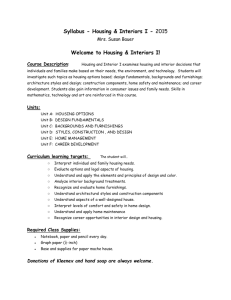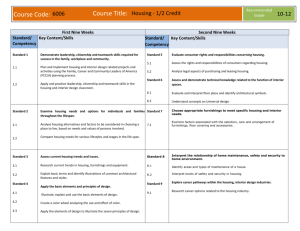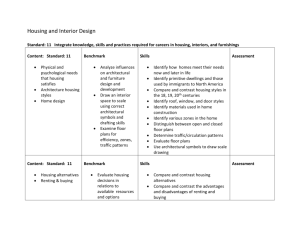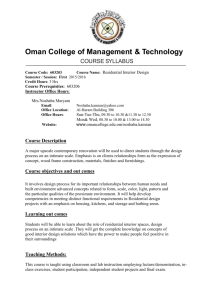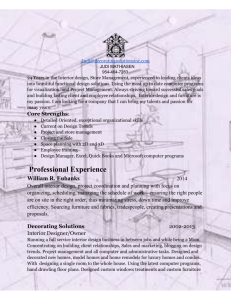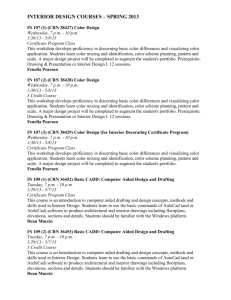ID-101U Design Fundamentals
advertisement
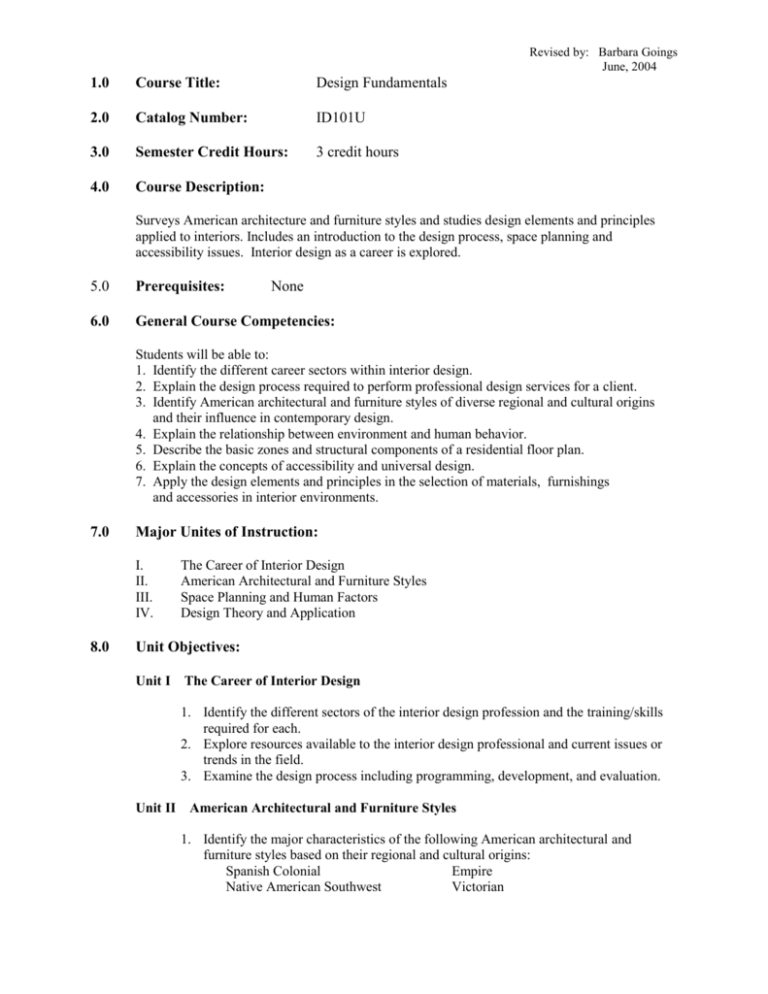
Revised by: Barbara Goings June, 2004 1.0 Course Title: Design Fundamentals 2.0 Catalog Number: ID101U 3.0 Semester Credit Hours: 3 credit hours 4.0 Course Description: Surveys American architecture and furniture styles and studies design elements and principles applied to interiors. Includes an introduction to the design process, space planning and accessibility issues. Interior design as a career is explored. 5.0 Prerequisites: None 6.0 General Course Competencies: Students will be able to: 1. Identify the different career sectors within interior design. 2. Explain the design process required to perform professional design services for a client. 3. Identify American architectural and furniture styles of diverse regional and cultural origins and their influence in contemporary design. 4. Explain the relationship between environment and human behavior. 5. Describe the basic zones and structural components of a residential floor plan. 6. Explain the concepts of accessibility and universal design. 7. Apply the design elements and principles in the selection of materials, furnishings and accessories in interior environments. 7.0 Major Unites of Instruction: I. II. III. IV. 8.0 The Career of Interior Design American Architectural and Furniture Styles Space Planning and Human Factors Design Theory and Application Unit Objectives: Unit I The Career of Interior Design 1. Identify the different sectors of the interior design profession and the training/skills required for each. 2. Explore resources available to the interior design professional and current issues or trends in the field. 3. Examine the design process including programming, development, and evaluation. Unit II American Architectural and Furniture Styles 1. Identify the major characteristics of the following American architectural and furniture styles based on their regional and cultural origins: Spanish Colonial Empire Native American Southwest Victorian Revised by: Barbara Goings June, 2004 Colonial New England Arts & Crafts, Prairie Georgian International Federal Vernacular, Eclectic 2. Explain the difference between historic restoration, renovation and adaptive reuse. Unit III Space Planning and Human Factors 1. Explain proxemics and relationships between the near environment and human behavior. 2. Identify the 3 basic zones, structural components and other requirements of a residential floor plan. 3. Identify architectural symbols on floor plan drawings. 4. Evaluate space planning according to universal design principles and the Americans with Disabilities Act (A.D.A.) requirements. 5. Identify floor plan types and current trends in housing. Unit IV Design Theory and Application 1. Use the design elements of space, shape/form, line texture, color, light and pattern in the selection of materials and furnishings used in interior environments. 2. Use the design principles of scale, proportion, balance, rhythm, emphasis to achieve harmony in interior environments. 3. Recognize different types of structural design and decorative design (naturalistic, stylized, abstract, geometric) and how they can be combined. 4. Develop unity in an interior using a dominant theme, architectural components, furnishings, decorative accessories and artwork. 9.0 Course Bibliography: Becoming an Interior Designer, Christine Piotrowski, John Wiley & Sons, 2004 Identifying American Architecture, John J. & G. Blumenson, W.W. Norton & Co. , 1981 Identifying American Furniture, Milo M. Naeve, Altamira Press, 1998 Interiors, Karla Nielson, David Taylor, McGraw Hill, 2002. Interior Design, John Pile, Prentice-Hall, 2003 10.0 Primary Instructional Methodologies: In-class and out-of-class assignments Illustrated lecture/discussion Field trip 11.0 Grading Criteria: Assignments Quizzes 90% 80% 70% 60% Below 100% 89% 79% 69% 59% A B C D F

